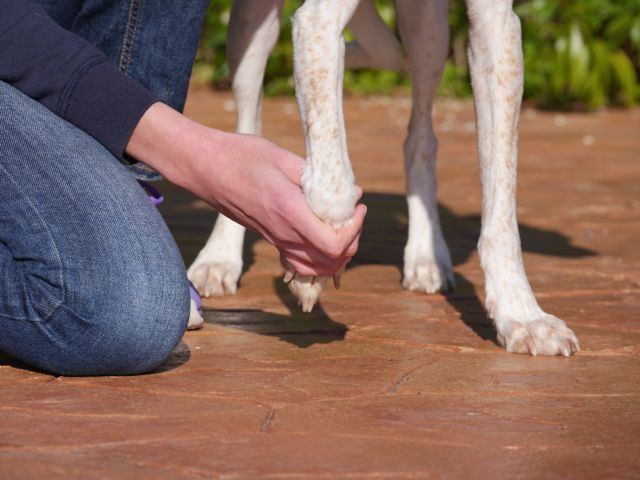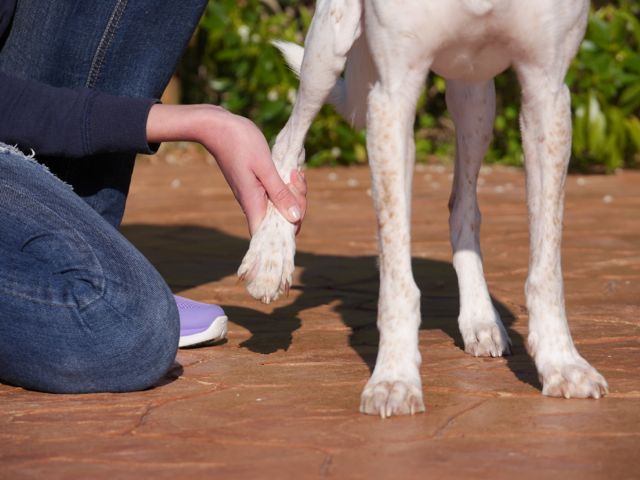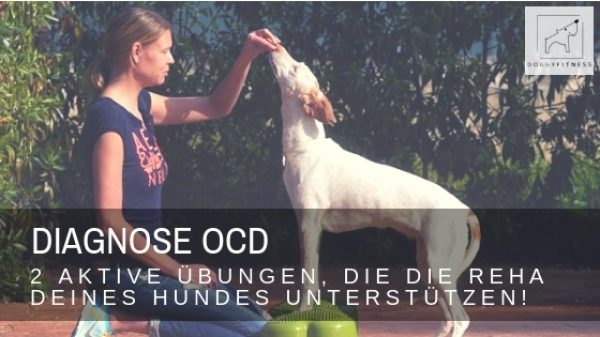How can you help your dog with shoulder OCD?
Your dog’s osteochondrosis dissecans (OCD) has been successfully treated? Now it’s all about supporting your dog to walk again without discomfort. I’ll show you two exercises. They are easy for you and your dog to learn. Most importantly, they are extremely effective and work in multiple ways. With regular use, you train the muscles and strength in the front legs. At the same time, you’ll promote joint mobility, coordination and confidence in the affected front leg.
The first exercise is the weight shift from front to back
This is how it works:
You kneel in front of your dog. Get him to stand on a rise with his front legs. The increase can be one step. But also some books or a low tree stump. The increase should correspond to the height of his wrists. This allows him to keep the weight shift stable. This causes him to shift his weight to his hind legs and lower back. Now take a treat and move it slightly forward in front of your dog’s nose. This is how your dog stretches his neck. He shifts his weight to his front legs. It thus trains the muscles of the front legs and shoulders. The hind legs remain in their original position. You hold this position for about 3-5 seconds. Then you give him the treat.
The second step:
Now, from the position, pass a second treat over your dog’s head so that he puts his head up. He will follow your hand. He now shifts his weight to his hind legs and lower back. You will also remain in this position. Before you give him the treat.
I recommend you do three forward and backward repetitions once a day to start.
You can increase this exercise by letting your dog stay in the position longer and increasing the number of repetitions.
The effect
This exercise is good for OCD because you are exercising the muscles of the front leg. At the same time it strengthens the confidence in the front leg. It also helps your dog’s coordination and balance.
BONUS: At the same time, the muscles of the hind legs and back are also trained. So a perfect full body workout!
The second exercise is the “paw lift”
And this is how the exercise works:
Your dog stands on a non-slip surface. You squat next to your dog. That way you can prop him up if he gets off balance. You grab the front leg (above the paw), lift it slightly. Hold the leg for about 3-5 seconds. On the hind legs, you also grab above the paw. Bend the barrel slightly. Just like you do when you dry your dog’s paw. Even if the exercise looks simple, effect and effort are high. Especially if your dog has a weak point in the musculoskeletal system.
Start with two repetitions per run twice a day. The duration of the hold can be increased up to 15 seconds. You can also increase the repetitions.
The effect
You strengthen with the exercise, the muscles of the runs and train the coordination of your dog. This is because every time you lift one of the three healthy legs, the dog is putting weight on the leg that is weakened by the OCD. At the same time, the joints are flexed and joint mobility is promoted.
BONUS: This exercise also gives your dog a workout for the muscles and flexibility of all four legs and gives your dog a good body feeling!


Extra tip: if your dog doesn’t want to put weight on his little foot after OCD, put a hair tie around the affected front leg (above the paw). This makes him aware of his leg and helps him use all four legs again.
Dieser Beitrag ist auch verfügbar auf:
Français (French)
Deutsch (German)
Español (Spanish)















